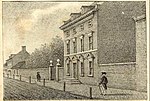Religious Liberty (Ezekiel)

Religious Liberty was commissioned by B'nai B'rith and dedicated "to the people of the United States" as an expression of support for the Constitutional guarantee of religious freedom. It was created by Moses Jacob Ezekiel, a B'nai B'rith member and the first American Jewish sculptor to gain international prominence. The statue was 11 feet (3.4 m) high, of marble, and the plinth (base) added another 14 feet (4.3 m). It weighed 26,000 pounds (12,000 kg), and was said to be the largest sculpture created in the 19th century. It was carved in Italy and shipped to Fairmount Park in Philadelphia for the nation's 1876 Centennial Exposition. It was later moved to Independence Mall and now (2023) stands in front of the National Museum of American Jewish History.
Excerpt from the Wikipedia article Religious Liberty (Ezekiel) (License: CC BY-SA 3.0, Authors, Images).Religious Liberty (Ezekiel)
South 5th Street, Philadelphia Center City
Geographical coordinates (GPS) Address Nearby Places Show on map
Geographical coordinates (GPS)
| Latitude | Longitude |
|---|---|
| N 39.95036 ° | E -75.1488 ° |
Address
Religious Liberty
South 5th Street
19148 Philadelphia, Center City
Pennsylvania, United States
Open on Google Maps








